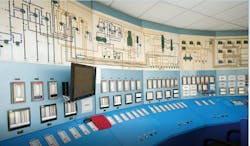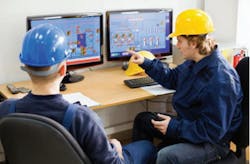Process manufacturing plants are famous, some would say notorious, for their tendency to keep automation systems and associated networks up and running for decades. Some estimates suggest that easily half of the automation systems controlling North American plants have parts that are at least 20 years old — and 30-year-old systems aren't rare either.
Those systems don't look like they did when they were initially installed. Hard disk drives, monitors and keyboards that receive constant use simply don't survive over decades, and such old equipment isn't available anymore.
If you ask your local computer store for an IBM XT motherboard and 20MB hard drive, you'll get some puzzled looks. So unless your automation systems are brand-new, they are likely multigenerational due to obsolescence and devices wearing out. In some cases, old subsystems and components may be replaced to allow for the higher functionality of newer equipment, such as with the human machine interface (HMI) subsystem. Making that kind of upgrade will probably include adding new PCs, with operating systems capable of supporting functionality that wasn't available when the original HMI was installed.
With the long operating history of many automation systems, some may be experiencing problems due to system providers going out of business or being acquired by other companies. Think back to the 1980s or even 1990s, the landscape of companies providing control systems was much different than it is now. If one is working with an automation system from one of those more-or-less "extinct" companies, you are probably all too aware of this reality.
Getting an automation system that includes multigenerational and multivendor components to work together can be a challenge. But that approach may be the only option when there aren't any practical alternatives, and end-users must be prepared to deal with the inherent challenges.
At some point, an old automation system that has not been upgraded will become a serious threat to production. As printed circuit boards and network devices get older, individual components begin to fail and systems fault more often. These cause unscheduled shutdowns and outages that are especially disruptive when replacement parts aren't available. Some companies specialize in recycling parts for these old systems, and there's always eBay, but supplies tend to get tighter and tighter over time. Individual components, especially the chips, are often long out of production and cannot be replaced. The automation vendor may try to create some sort of functional replacement, but redesigning an old board with new components is expensive — which will be reflected in the price.
If you know a plant is going to be shut down or go through a major redesign for a specific period of time in the near future, one can limp along with the old system until that date. But that's not an appropriate long-term strategy, and eventually the system will have to go through some type of upgrade or migration. For purposes of this discussion, an upgrade is defined as adding newer elements, but largely sticking with the same automation system vendor and platform. A migration occurs when you make a major platform change, typically involving a different vendor, but sometimes sticking with the original manufacturer.
TWO PROJECT PATTERNS
Replacing some part of an automation system with something newer typically follows one of two patterns. The first pattern encompasses multigenerational systems. In these cases, the original company is typically still in business and has created upgrade strategies that allow users to add new parts to an old platform, gradually bringing up the whole system on a modular basis a bit at a time and without any major disruptions. This is not an easy accomplishment, and successful execution requires strategic planning.
While improvements may have to be bolted on to older systems, it is usually not quite so literal.But when older equipment is no longer available, there is often no other choice.
A multigenerational platform is a good way to update your automation system, but it isn't possible in every case. Even if you remain with the original vendor, it is still important to be aware of the support dates for each piece of the automation system. Often, certain controllers or nodes lose support before others, so you need to incorporate this into the timing of the upgrades.In the second pattern, new elements from a different vendor are "bolted on" to an existing automation system. This is difficult to pull off in the real world. Such a system can be buggy, and it won't have the greatest vendor support.
Personal experience working with many different types of automation platforms has proven these bolt-on solutions are rarely successful over the long term. Bolt-on solutions are really only temporary bandages, used either to add a few years to the older system or as a part of a larger phased migration plan that will change the bolt-on components to an integral part of an entirely new automation system.
BOLT-ON OR BOLT THE DOOR?
Bolt-on solutions may be necessary for discontinued legacy systems, but often we instead see them as the result of a vendor's aggressive cross-platform competitive attack. In our experience, one supplier trying to dislodge another often uses a bolt-on solution as a means to get in the plant and establish a position for getting deeper into the system. Unfortunately, we have seen too many situations where the effectiveness of these solutions was over-promised in the sales and marketing process.
So if a company is faced with making an upgrade but not ready for a rip-and-replace approach, following a cross-platform, multigenerational upgrade or migration to a new automation system may be the best path to take. There will be complications, but they can be managed if a comprehensive project plan is developed ahead of time.
EVALUATING AN UPGRADE PROJECT
Why do people upgrade or migrate? Today, the biggest drivers stem from lifecycle issues. And, unfortunately, adding functionality is usually a distant second priority. MAVERICK shows customers where there can be improvements, but adoption of those recommendations during a migration project is pretty rare. The justifications for adding improvements don't often make it into the business case argument in a compelling manner — or there may be other corporate financial issues that preclude all but the essential expenditures.
Years ago (pre-recession), companies might have gone to management asking to begin migrating before a complete collapse of the old system. They would point out the new capabilities they were getting and how they would improve production and cut operating costs. That sort of thing doesn't happen as much today. Companies will rarely even discuss an upgrade or migration until the old system is coughing up blood.
For those who want a plant that is able to run reliably and safely for years to come, think of any solution one could consider permanent and act appropriately. That's one reason bolt-on solutions tend to disappoint; they often become permanent. Once word gets out that a company is considering some type of automation improvements, vendors will come with sales pitches, simulations and lots of promises. It's here a systems integrator can help sort through the hype and determine what is actually possible, offering unbiased assessments of what products and migration paths actually work.
This control room is making use of a modern HMI system, one that will be fully supported by vendors for years to come, as well as offering superior performance as compared to older vintage HMIs.
Cross-platform, multi-generational projects are not easy, and you'll need all the help you can get. All vendors can show you good projects, but each one has also had unmentioned disasters. On the other hand, an independent system integrator can speak freely with you about both the successes and failures of a particular vendor.As you consider launching a project, there are a few basic questions that need to be answered:• Functionality — What do you expect from your new system at the completion of a successful transition? What new capabilities do you expect to add? Smart I/O? APC? Better enterprise connections?
• Cost — Is your company willing to spend some money to achieve production improvements, or is this a quick and dirty venture for the lowest possible cost?
• Operators — What will the operators see? New, more modern HMIs with improved alarm management — or the same old thing?
• Schedule — Is there time to plan, or is this an emergency project due to major plant failures? Can the project be timed to accompany a shutdown, or will everything need to be cut over hot?
Some suppliers oversell the capabilities of bolt-on approaches, so an integrator provides the voice of reason. This can mean dumping cold water on some of the sales pitches — a necessary, if often unpleasant, task.
Don't underestimate the value of having equipment that is still being manufactured. You might have forgotten how nice it is to be able to buy spare parts off the shelf. With that in mind, you need to think about what you're buying in the context of a 15–20 year lifespan and associated total cost of ownership issues.
Does the platform have a guaranteed support date? Does the vendor have a solid record of supporting its platforms for as long as planned? Is this a newer-model automation system, or does the vendor have another system in development that will soon replace the current offering in both support and focus?
New equipment will bring new functionality, and things will not be exactly as they were — nor should they be — as there will typically be many opportunities for improvements when obsolete components are replaced with newer offerings. We often bring in operators early in a project to educate them as to how a new system can be used to improve operations. This typically includes better graphics, improved techniques for interacting with the HMIs, simpler alarm management and so forth. We explain the concepts of high-performance graphics, supported by findings from the Abnormal Situations Management Consortium, and show what they should expect to see when the new automation system is up and running.
While it's OK to keep your basic control strategies, I/O and field devices constant for the most part, you don't want to replicate all of the old functionality in the new automation system. Trying to make a new system behave like an old one ignores many useful improvements, can create a maintenance nightmare, and usually requires going to great lengths just to make everything work.
Even so, we sometimes have to convince customers to use the built-in capabilities they'll be getting with the new automation system. Any integrator needs to make a convincing argument as to why each benefit is better for a given customer's specific situation, and show them where the technology is going and explain why deviating from a vendor's preferred path can be very expensive.
Before anyone begins to explore available solutions or listen to the first vendor presentation, it's best to dig deep in the planning process with questions including:
• How does the plant run in terms of continuous versus batch, manual versus automatic, and other areas?
• What's the type of production? Long product runs? Short ones? Lots of variations?
• How much money is available?
• What is the condition of the existing automation system infrastructure?
• Does the scope consider immediate needs and future expectations?
• If you put new controllers in one part of the plant, will those talk to the old controllers?
• Are there supervisory controls that need to talk to both generations of controllers?
Upgrading the HMI portion of an older, existing automation system can ease implementation of modern tools such as this remote access device.
Companies frequently get in trouble right out of the gate because they don't evaluate their controllers and networks adequately. New systems invariably create more network traffic and require more processing power, and not all existing systems can handle the extra load.Here's an example of what can happen if a proper upfront evaluation hasn't been completed:• A plant or process unit wants to install a new HMI to work with existing controllers.• The plant doesn't study network traffic and controller loading because everything works fine right now, but they don't realize they're already on the edge of capacity.• Taking a leap of faith that everything will work just like the snazzy simulation shown by the new supplier, they take out all the old equipment and install the new HMIs.• The system crashes when they cut over.• Realizing that might be a possible outcome, another company decides to have both HMI systems work in parallel so that the old one can serve as a temporary backup, but both crash because having both systems requires even more network resources.There's no substitute for proper planning and testing upfront, as a relatively small amount of time and money spent on these tasks can prevent disastrous results down the road.
NO EASY ANSWERS
There's no universal best platform or solution because each one has its particular strengths for specific types of applications. There's also no single leading automation system or migration path, as many factors lead to the best choice for each project. There is much at stake in such projects because the loss of a week's production, or even a couple days, can easily be worth far more than the cost of the project. In fact, downtime costs often make a true rip-and-replace approach infeasible due to the economics of lost production, forcing a phased upgrade or migration.
Every situation is different, and what works in one facility may not work for another. Success comes from a combination of a deep understanding of the process and control strategy, what kind of shape your controllers and networks are in now, and what functionality is needed. Working with an integrator or other unbiased advisor can be a source for straight answers for a specific situation. All of this needs to be done very early in the planning process, so that the projects can be scoped, scheduled and budgeted correctly.









